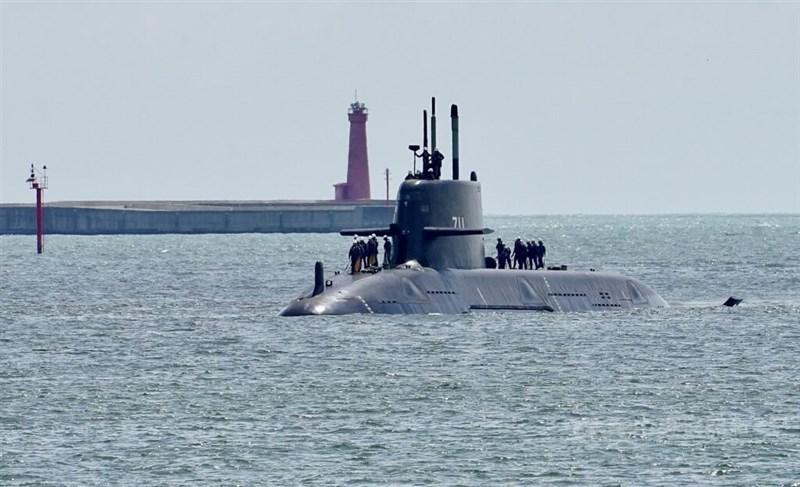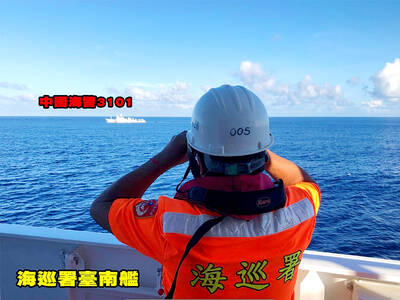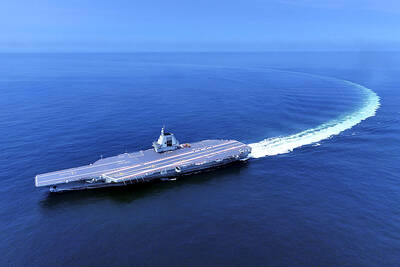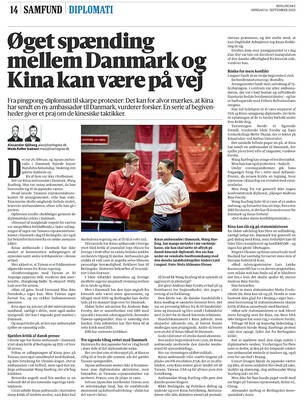Taiwan's first indigenous defense submarine, the Hai Kun (海鯤), or “Narwhal,” yesterday completed tests involving its propulsion, rudder, electricity, communication and navigation systems during its first day of floating navigation trials just outside the Port of Kaohsiung, its builder said late last night.
CSBC Corp, Taiwan said in a statement that it would fine-tune the systems based on the test results before moving on to the next stage of the submarine's sea trials.
The three stages of a submarine's sea trials are floating navigation, shallow depth testing and gradual depth increase testing, CSBC said.

Photo: CNA
In shallow depth testing, the submarine submerges to a shallow depth to test basic systems, the shipbuilder said.
During gradual depth increase tests, the submarine submerges further, testing systems at different pressures and depths to make sure the vessel can meet its combat needs, CSBC said.
Each of the three stages would feature several trials and adjustments to related systems, it added.
The navy and technicians involved with the parts and systems used in the prototype also took part in yesterday's trial, CSBC said.
The shipbuilder's statement confirmed what a military source said earlier in the day — that the Narwhal had begun sea trials after completing harbor acceptance tests, despite several delays.
Under the original timeline set by the Ministry of National Defense, the Hai Kun's sea trials were supposed to begin in April and be completed by Sept. 30 to meet a November delivery deadline.
Without directly confirming the delay, Minister of National Defense Wellington Koo (顧立雄) said in an interview last month that the submarine's sea trials would only begin once all safety requirements were fully met.
Despite the delayed start to the sea trials, the contractual November deadline for the submarine to be delivered to the navy remained unchanged, navy Chief of Staff Chiu Chun-jung (邱俊榮) said yesterday.

The Coast Guard Administration (CGA) yesterday said it had deployed patrol vessels to expel a China Coast Guard ship and a Chinese fishing boat near Pratas Island (Dongsha Island, 東沙群島) in the South China Sea. The China Coast Guard vessel was 28 nautical miles (52km) northeast of Pratas at 6:15am on Thursday, approaching the island’s restricted waters, which extend 24 nautical miles from its shoreline, the CGA’s Dongsha-Nansha Branch said in a statement. The Tainan, a 2,000-tonne cutter, was deployed by the CGA to shadow the Chinese ship, which left the area at 2:39pm on Friday, the statement said. At 6:31pm on Friday,

The Chinese People’s Liberation Army Navy’s (PLAN) third aircraft carrier, the Fujian, would pose a steep challenge to Taiwan’s ability to defend itself against a full-scale invasion, a defense expert said yesterday. Institute of National Defense and Security Research analyst Chieh Chung (揭仲) made the comment hours after the PLAN confirmed the carrier recently passed through the Taiwan Strait to conduct “scientific research tests and training missions” in the South China Sea. China has two carriers in operation — the Liaoning and the Shandong — with the Fujian undergoing sea trials. Although the PLAN needs time to train the Fujian’s air wing and

The American Institute in Taiwan (AIT) put Taiwan in danger, Ma Ying-jeou Foundation director Hsiao Hsu-tsen (蕭旭岑) said yesterday, hours after the de facto US embassy said that Beijing had misinterpreted World War II-era documents to isolate Taiwan. The AIT’s comments harmed the Republic of China’s (ROC) national interests and contradicted a part of the “six assurances” stipulating that the US would not change its official position on Taiwan’s sovereignty, Hsiao said. The “six assurances,” which were given by then-US president Ronald Reagan to Taiwan in 1982, say that Washington would not set a date for ending arm sales to Taiwan, consult

A Taiwanese academic yesterday said that Chinese Ambassador to Denmark Wang Xuefeng (王雪峰) disrespected Denmark and Japan when he earlier this year allegedly asked Japan’s embassy to make Taiwan’s representatives leave an event in Copenhagen. The Danish-language Berlingske on Sunday reported the incident in an article with the headline “The emperor’s birthday ended in drama in Copenhagen: More conflict may be on the way between Denmark and China.” It said that on Feb. 26, the Japanese embassy in Denmark held an event for Japanese Emperor Naruhito’s birthday, with about 200 guests in attendance, including representatives from Taiwan. After addressing the Japanese hosts, Wang